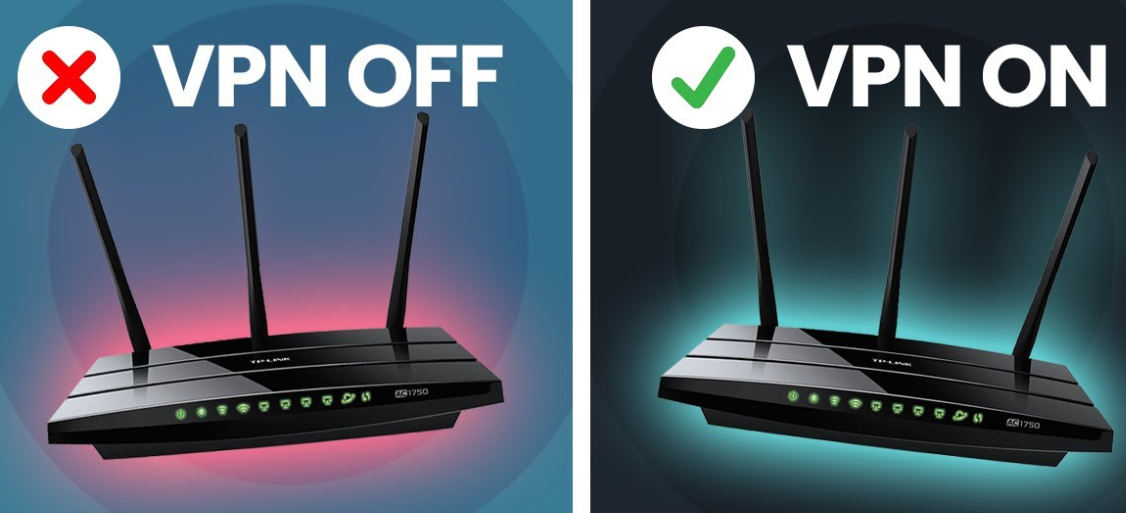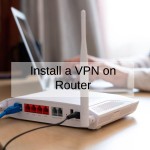In today's digital age, ensuring online privacy and security has become paramount. With the increasing number of cyber threats and privacy concerns, individuals are seeking ways to safeguard their internet activities. One effective solution that has gained popularity is the use of Virtual Private Networks (VPNs). These tools encrypt your internet connection, providing a secure pathway for data transmission. In this comprehensive guide, we'll walk you through the process of setting up a VPN on your TP-Link router, ensuring network-wide protection for all your connected devices.

Understanding Your TP-Link Router
Before diving into the VPN setup process, it's essential to familiarize yourself with your TP-Link router. TP-Link routers are known for their reliability and user-friendly interface, making them an excellent choice for both beginners and experienced users alike. Whether you own a TP-Link Archer, Deco, or any other model, setting up a VPN can be a straightforward process with the right guidance.
Researching Compatible VPN Services
Not all VPN services are created equal, and not all are compatible with TP-Link routers. Therefore, it's crucial to conduct thorough research to find a VPN provider that meets your specific needs while being compatible with your TP-Link router. Look for VPN services that offer robust encryption protocols, a wide range of server locations, and excellent device compatibility.
Choosing the Best Free VPN for Your Needs
When selecting a VPN for your TP-Link router, consider factors such as speed, security features, and ease of use. For those on a budget, there are also several best free vpn options available, although they may come with limitations such as data caps or slower speeds.
Preparing Your Router for VPN Setup
Before proceeding with the VPN setup, ensure that your TP-Link router is up to date with the latest firmware. This step is crucial as it ensures compatibility and stability during the setup process. Access your router's admin panel by typing its IP address into your web browser and entering your login credentials.
Configuring VPN Settings on Your TP-Link Router
Once you've accessed the router's admin panel, locate the VPN settings section. Here, you'll need to input the VPN server information provided by your chosen VPN provider. This typically includes the server address, protocol, username, and password. Follow the step-by-step instructions provided by your VPN service to complete the configuration process.
Setting Up VPN on Multiple Devices
One of the significant advantages of setting up a VPN on your TP-Link router is the ability to protect multiple devices simultaneously. Once the VPN is configured on the router, any device connected to the network will automatically benefit from the encrypted connection. This includes smartphones, tablets, laptops, smart TVs, and more.
Testing Your VPN Connection
After configuring the VPN settings on your TP-Link router, it's essential to test the connection to ensure everything is functioning correctly. You can do this by visiting a website that displays your IP address before and after connecting to the VPN. Additionally, perform speed tests to assess any impact on internet performance.
Exploring Additional VPN Features
In addition to encrypting your internet connection, many VPN services offer additional features such as ad-blocking, malware protection, and split tunneling. These features can further enhance your online security and privacy while providing a more seamless browsing experience. Explore the settings of your chosen VPN service to take advantage of these features.
Securing Your VPN Gateway
Securing your VPN gateway is crucial to prevent unauthorized access to your network. Ensure that you're using strong, unique passwords for both your router's admin panel and the VPN service. Additionally, consider enabling features such as two-factor authentication for an added layer of security.
Maximizing VPN Performance
To maximize VPN performance on your TP-Link router, consider optimizing the settings for your specific needs. This may include selecting the fastest VPN server locations, adjusting encryption settings, or enabling features such as Quality of Service (QoS) to prioritize VPN traffic.
Ensuring VPN Reliability
To ensure continuous VPN connectivity, configure your router to automatically reconnect to the VPN in case of disconnection. Most VPN services offer options to enable automatic reconnection within their settings menu. Additionally, regularly monitor your VPN connection to detect any potential issues proactively.
Exploring VPN Apps for Easy Access
While setting up VPN directly on your TP-Link router provides network-wide protection, you may also want to consider using VPN app on individual devices for added convenience. Many VPN providers offer dedicated apps for various platforms, including Windows, macOS, Android, and iOS.
Reviewing Best Practices for VPN Online Usage
As you embark on your journey to secure your vpn online activities with a VPN, it's essential to follow best practices to maximize its effectiveness. This includes regularly updating your VPN software, avoiding public Wi-Fi networks without VPN protection, and being cautious of phishing attempts.
Setting up a VPN on your TP-Link router is a proactive step towards enhancing your online security and privacy. By following the steps outlined in this guide and choosing the best VPN for your needs, you can enjoy peace of mind knowing that your internet activities are encrypted and protected from prying eyes. Take control of your online privacy today by setting up a VPN on your TP-Link router.
How to Set Up VPN on TP-Link Router
Setting up a VPN on your TP-Link router is a straightforward process that empowers you to safeguard all devices connected to your network. Begin by accessing the router's admin panel through your web browser. Navigate to the VPN settings section and input the server information provided by your chosen VPN service. Follow the step-by-step instructions to complete the configuration, ensuring seamless integration with your TP-Link router.
Best VPN Right Now
Choosing the best vpn service is paramount to the success of your network security endeavors. Among the plethora of options available, several VPN providers stand out for their reliability, speed, and robust encryption protocols. Some of the top contenders in the VPN market currently include ExpressVPN, NordVPN, and CyberGhost. These services offer a comprehensive suite of features, including high-speed servers, military-grade encryption, and user-friendly interfaces, making them ideal choices for securing your TP-Link router.
Easy Way to Install VPN on TP-Link Router
The installation process for VPN on TP-Link router is designed to be user-friendly, even for those with limited technical expertise. With intuitive interfaces and clear instructions, VPN setup can be completed in a matter of minutes. Most VPN providers offer dedicated tutorials and support resources to guide you through the process, ensuring a hassle free installation vpn free experience.
Configuration of VPN on TP-Link Router
Once installed, configuring your VPN on TP-Link router allows you to tailor the settings to suit your specific requirements. From selecting preferred encryption protocols to defining server preferences, configuration options abound to optimize your VPN experience. Explore the settings menu on your router's admin panel to customize your VPN setup according to your preferences.
Automatic Configuration of VPN on TP-Link Router
Automatic configuration options streamline the VPN setup process, allowing you to effortlessly integrate VPN functionality into your TP-Link router. By selecting automatic configuration settings, your router will automatically connect to the VPN server upon startup, ensuring continuous protection without manual intervention.
Manual Configuration of VPN on TP-Link Router
For users seeking greater control over their VPN setup, manual configuration options provide a deeper level of customization. By manually inputting server information and encryption settings, you can tailor your VPN setup to meet your specific security and performance requirements. While manual configuration may require additional time and technical expertise, it offers unparalleled flexibility and control over your VPN setup.
Why and When to Use VPN on TP-Link Router
The decision to use a VPN on your TP-Link router is driven by a myriad of factors, including privacy concerns, security threats, and the need for unrestricted access to online content. VPNs are particularly beneficial when accessing public Wi-Fi networks, conducting sensitive transactions, or bypassing geo-restrictions imposed by content providers. By encrypting your internet connection at the router level, VPNs provide a blanket of security that extends to all devices connected to your network, regardless of their location.
Why Should You Use VPN on TP-Link Router
The advantages of using a VPN on your TP-Link router are manifold. Firstly, VPNs encrypt your internet traffic, preventing third parties from intercepting and monitoring your online activities. This is particularly crucial when accessing sensitive information such as financial transactions or personal data. Additionally, VPNs mask your IP address, preserving your anonymity and safeguarding your privacy online. By rerouting your internet connection through remote servers, VPNs also enable you to bypass censorship and access geo-restricted content with ease.
How to Get VPN on TP-Link Router
Obtaining a VPN for your TP-Link router is a simple process that begins with selecting a reputable VPN provider. Research different VPN services to identify one that aligns with your needs in terms of features, pricing, and server locations. Once you've chosen a VPN provider, sign up for a subscription plan and vpn download the necessary software or configuration files. Follow the provider's instructions to complete the setup process, and you'll be well on your way to securing your TP-Link router with a VPN.
Router Compatibility:
- TP-Link Router Models: TP-Link routers vary in their support for VPN configurations. Some models may support VPN settings in their firmware, while others may not.
- Firmware Support: TP-Link routers typically support firmware like DD-WRT and OpenWRT, which offer more advanced VPN configuration options.
Setup Process:
- TP-Link Firmware Settings:
- Log in to the router's web interface using a web browser.
- Navigate to the VPN section (may vary depending on router model and firmware).
- Enter VPN server details provided by your VPN service provider.
- Configure encryption, authentication, and other settings as required.
- Third-Party Firmware Installation:
- Install third-party firmware like DD-WRT or OpenWRT on your TP-Link router for more advanced VPN configuration options.
- Follow firmware-specific instructions to configure VPN settings.
Security Features:
- Encryption: TP-Link routers typically support encryption protocols like PPTP, L2TP, and OpenVPN for securing VPN connections.
- VPN Passthrough: Most TP-Link routers support VPN passthrough, allowing VPN traffic to pass through the router without interference.
Device Compatibility:
- All Connected Devices: Setting up VPN on TP-Link router secures all devices connected to the network, including smartphones, computers, smart TVs, and IoT devices.
- No Individual Setup: Users don't need to configure VPN connections individually on each device, simplifying the process and ensuring all devices are protected.
Performance and Stability:
- Router Processing Power: The performance and stability of VPN connections on TP-Link routers may vary depending on the router's processing power and available memory.
- Server Selection: Choosing VPN servers closer to your physical location can improve performance and reduce latency.
Advantages and Benefits of VPN on TP-Link Router
The advantages of implementing a VPN on your TP-Link router are multifaceted. Firstly, VPNs offer enhanced security by encrypting your internet connection, shielding your sensitive data from cyber threats and malicious actors. Additionally, VPNs provide anonymity by masking your IP address, preserving your privacy and anonymity online. By bypassing geo-restrictions and censorship, VPNs enable access to a broader range of online content, including streaming services, social media platforms, and news websites. Moreover, VPNs facilitate secure remote access to corporate networks, allowing employees to work from anywhere without compromising sensitive information.
Setting up a VPN on your TP-Link router is a prudent investment in safeguarding your online privacy and security. By encrypting your internet connection and masking your IP address, VPNs provide a robust defense against cyber threats and intrusive surveillance. Whether you're accessing public Wi-Fi networks, circumventing geo-restrictions, or protecting sensitive data, a VPN on your TP-Link router offers unparalleled peace of mind and security in an increasingly digital world.
FAQ
Q1 Can I set up VPN on any TP-Link router?
- Not all TP-Link routers support VPN configurations. Check your router's specifications or documentation to determine if VPN settings are available.
Q2 What VPN protocols are supported on TP-Link routers?
- TP-Link routers typically support protocols like PPTP, L2TP, and OpenVPN for VPN connections.
Q3 Can I set up VPN on TP-Link router without technical knowledge?
- Basic understanding of router administration and networking concepts is helpful, but TP-Link provides user manuals and online resources to guide users through the setup process.
Q4 Will setting up VPN on my TP-Link router slow down my internet speed?
- VPN encryption/decryption can add overhead to router processing, potentially affecting internet speed. However, choosing VPN servers with low latency and higher bandwidth can mitigate this impact.
Q5 How do I troubleshoot VPN connection issues on my TP-Link router?
- Check VPN settings for accuracy, ensure router firmware is up to date, and verify internet connectivity. Refer to TP-Link's support documentation or contact customer support for further assistance.











